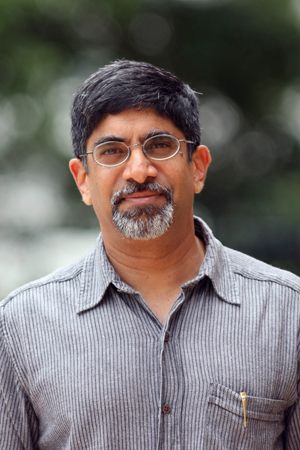
The COVID-19 outbreak, whose epicenter is in the Chinese city of Wuhan, has now spread to over 100 countries. Photo: @helloimnik / Unsplash
As coronavirus spreads globally, journalists around the world are working to hold officials to account as they respond to the crisis.
As of publishing this story on March 10, there were 114,452 cases of COVID-19 around the globe, which resulted in 4,026 deaths, according to Johns Hopkins University & Medicine’s COVID-19 Map. At this time, there are far more questions than answers. The outbreak, whose epicenter is in the Chinese city of Wuhan, has now spread to over 100 countries.

Thomas Abraham. Photo: Journalism and Media Studies Centre, Hong Kong University.
Thomas Abraham is a veteran health journalist, an expert on infectious disease and global health security, and a former consultant to the World Health Organization. He is the author of Twenty-first Century Plague: The Story of SARS and most recently, Polio: The Odyssey of Eradication. A former editor for the South China Morning Post and foreign correspondent for The Hindu newspaper, he is an Honorary Associate Professor at Hong Kong University’s Journalism and Media Studies Centre.
In this conversation with Amruta Byatnal for GIJN, Abraham explains the questions that investigative journalists need to ask in a rapidly changing environment.
GIJN: What is the role of investigative journalists right now?
Thomas Abraham: Our main role is to follow the news, and report it in context. One of the big issues we have now with the coronavirus outbreak is that the easiest thing to report are the headline figures. So we just report what people are saying. And what people are saying is basically what they think is important, not necessarily what the public believes to be important.
What we need to do is explain in a sense that we are there on behalf of the public, trying to find out what is going on. One the one hand reporting [on COVID-19] is really easy because there is more information now than we’ve ever had for any other disease — we’ve got daily figures, press conferences, all sorts of people saying things, lots of people willing to be quoted, so it’s easy to put together a story.
But what is really hard is to try and understand the meaning of all this — what do these figures really mean? And how is the public supposed to respond? Does this mean that every new case is going to die? As journalists, the first thing we really need to be able to do is put this in context. And that is not easy because people are just following press conferences and getting headline figures. The press release is not the story. That’s the beginning of a story.
These are messages targeted to the governments saying, “Do something quickly.” They don’t necessarily give the public a handle on what this really means for us. This is where journalism is extremely important in terms of understanding what these figures are, putting them in context and really knowing what questions to ask.
GIJN: Are there any obvious gaps you’re seeing right now?
Thomas Abraham: To give an example, Hong Kong reported a case of a 69-year-old woman who had been in Delhi from Jan. 31 to Feb. 24. She had diarrhea, and by the time she got to Hong Kong, she felt worse. If she had been in India this whole month, she clearly caught this in India. So an obvious thing would be to look at whether other cases in Delhi were reported during this period. If there are no cases at all, what does this tell us? That surveillance is bad and there’s clearly circulation.
Once you have this framework, this is when you start asking questions. It doesn’t matter what people are telling you. What do you want to know? And then you get a much more interesting story than saying, “23 new cases were reported in India today.”
This is what investigative journalism is — looking at figures, finding patterns for yourself, and trying to find anomalies, and then going to people and asking them, how do you explain this?
This is not happening at all. The agenda is being set by press conferences.
The other big issue is what happens to the 20% of people who fall seriously ill? Where are they going to go? How many ICU [intensive care unit] beds and ventilators do hospitals have? What happens to those who are already in ICU? This is what journalists should be doing — driving the story. There’s so much that needs to be done, and can be done.
GIJN: What do you make of the focus on China’s response to the outbreak?
Thomas Abraham: Most of the investigative journalism has focused on the China cover-up which I don’t think is a great story. Everybody is convinced that China did a lousy job, which it didn’t. There was a sense that they hid the number of cases. In the early stages of the disease, when you don’t even know how to define it — all you know is that people are coming in with some sort of pneumonia and this is the winter, which is the height of the pneumonia season. Within that, to zero in and say this small subset is caused by a new bug is really difficult until you get the cases analysed, which happened in a week or so.
China is China and they will suppress things, but this time actually they haven’t suppressed. All they’ve said is that any information should come from the government, and we don’t want doctors talking about this. Which, to be honest, is not very different from India. So the China secrecy stories are easy ones to write, and in the course of writing these, you tend to miss out what the real story is. And the real story at that point of time was to know how severe it was. How worried should we be? Ultimately, what percentage of people is it killing? What percentage of people need to go into the hospital?
GIJN: What are the lessons from SARS that we should be paying heed to now?
Thomas Abraham: I have lived through SARS so I know what it’s like. When people suddenly start rushing to emergency departments [and] testing services break down. The questions to ask are, “Do we have enough testing kits? Who is manufacturing them, where are they distributed?” Once we focus on these things, it also helps put public pressure on governments, who are then forced to respond.
It’s not rocket science, it’s basically taking things to their logical conclusion, rather than stopping at what somebody is saying. It’s the method of all journalism — to keep asking — so what, so what? And part of it is also looking forward — if cases are going up, that means X, Y, and Z are going to have to happen. Is this actually happening?
GIJN: Has any coverage stood out for you?
Thomas Abraham: There’s been a lot of good explanatory journalism. Everything we know about this outbreak is because of journalists. The question is, how much further can we take this? Can we push the story forward? This is what investigative journalism should be doing.
GIJN: What is the one big mistake that investigative journalists should avoid?
Thomas Abraham: One big mistake to avoid is jumping to conclusions. Don’t be in a hurry. Spend more time in understanding the basics. Find the right people to talk to — a lot of people who haven’t done such health reporting will talk to any medical person, such as a doctor. Most medical people are so specialized now that you could end up talking to someone who doesn’t know much about infectious diseases. How do you find the right people? A lot of real-time science is coming out — so it’s easy to know who the people are.
One more thing to remember is that science that is evolving as rapidly as this is hedged by huge amounts of uncertainty because you only know so much. It is also important to know that scientists often disagree with each other. And the biggest thing to keep in mind is that things may change tomorrow. This is a huge learning opportunity for journalists. Once you’ve done this, you’ll emerge better prepared for the next epidemic. There will always be a next one.
 Amruta Byatnal is a journalist based in New Delhi. She is an associate editor at Devex, and her reporting focuses on gender, health, and citizenship.
Amruta Byatnal is a journalist based in New Delhi. She is an associate editor at Devex, and her reporting focuses on gender, health, and citizenship.

Why can’t 75 year plus seniors not get The COVID Vaccine on MIchigan while 50 year olds in other states are getting them?